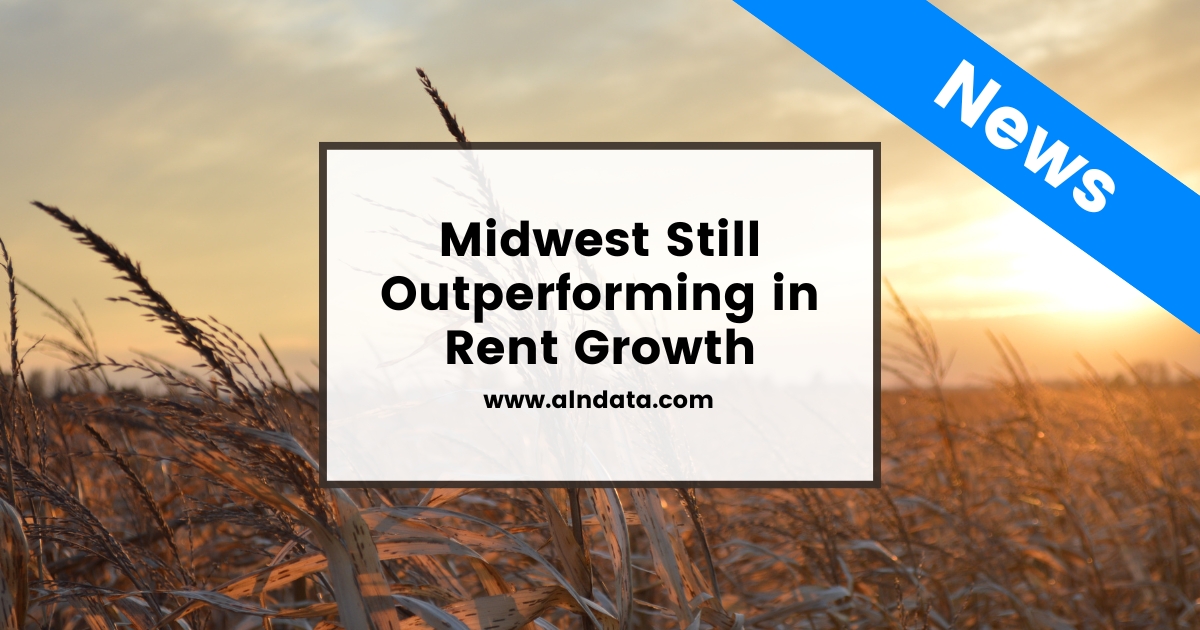Midwest Still Outperforming in Rent Growth
Despite national average occupancy and average effective rent change both losing ground in recent months, a handful of Midwestern markets have stood out in a positive way. This region generally performed well relative to other parts of the country in 2023 after not being at the cutting edge of rent growth in the 2021 and 2022 period. In fact, when partitioning according to NAA region, the two regions that make up the broader Midwest led the nation in average effective rent growth for new leases last year.
Over the last six months, Columbia, MO (5.2%), Evansville, IN (3.2%), Green Bay – Appleton, WI (3.1%), Madison, WI (2.4%), Cleveland – Akron OH (2.1%), and Moline, IL (1.8%) have managed to achieve average effective rent growth for new leases well above the 1% decline measured at the national level.
All numbers will refer to conventional properties of at least 50 units.
Apartment Demand Remains Inconsistent
The positive rent performance has had less to do with robust demand. However, this is not to say there have not been bright spots. Whether evaluating over the last twelve, six, or three months, Madison net absorption has been consistently good. Net absorption of 2,800 units in the last six months was equal to about 4% of existing conventional stock there. Another area where apartment demand has been relatively strong has been Evansville. The slightly more than 400 net absorbed units there in the last six months was a much smaller number, but that absorption represented nearly 3% of existing stock.
Of six Midwestern markets that have outperformed in rent growth recently, three have suffered negative net absorption over the last six months. A net loss of approximately 450 leased units in the Moline market represented the low mark on a market size-adjusted basis with those units accounting for almost 2% of existing conventional stock. Additionally, there was a net loss of more than 350 net leased units in the Green Bay region and a net loss of around 600 leased units in the Cleveland – Akron market in the same period.

In our series Takeaways, ALN Apartment Data Senior Market Analyst, Jordan Brooks, shares more insight into the final thoughts on the April 2024 newsletter article…
New Supply and Its Impact on Average Occupancy
As a general statement, a below-average influx of new units into these markets has allowed average occupancy to remain above the national average despite some inconsistency in apartment demand. In the last six months, the average U.S. market has seen new units delivered equaling 1.3% of existing conventional stock. For these six Midwestern markets, that average has been 0.7%.
As with the demand picture, there has been some variance at the market level, but to a lesser degree. Only the 550 new units delivered in Moline, which total around 2% of existing stock, were more than the 0.7% average for this group of markets. On the other end of the spectrum, there were no new units delivered in the last six months in Columbia. For the remaining four markets, each saw new supply equal to between 0.5% and 0.6% of existing conventional stock in the period.
As a result of the relative lack of new supply in recent months, average occupancy for these markets has remained considerably higher than the national average of 89%. To be clear, this national average includes all properties rather than only stabilized properties. This is because as new properties stabilize, they are being immediately replaced by new lease-ups as the multifamily construction boom rolls on in 2024. This overall average paints a clearer picture of conditions on the ground than does an average that eliminates the more than 750,000 units across the country in properties that have yet to stabilize.
The average occupancy for these six Midwestern markets ended January at 92%. Madison, with a 90% average, was the lowest. Both Columbia and Evansville closed the month at around 95% – a level that was more common in late 2021.
Takeaways
The Midwest region has been a leader in rent growth for some time now, and a handful of markets have been at the forefront of those results. While there have been examples such as Madison and Evansville of apartment demand being a major component of that rent performance, the more consistent driver has been less new supply pressure allowing for higher occupancy.
Looking ahead, multifamily new supply will remain elevated this year, and probably next year as well, but the Midwest region is not expected to suddenly be at the tip of the new supply spear. Milwaukee and Madison will be active, but the new supply headwind facing many Sunbelt and Mountain West markets this year will be much less fierce for the Midwest. As such, the region may well be set to outperform in rent growth again in 2024.
Disclaimer: All content and information within this article is for informational purposes only. ALN Apartment Data makes no representation as to the accuracy or completeness of any information in this or any other article posted on this site or found by following any link on this site. The owner will not be held liable for any losses, injuries, or damages from the display or use of this information. All content and information in this article may be shared provided a link to the article or website is included in the shared content.

